An Experimental Demonstration of the Effective Application of Thermal Energy Storage in a Particle-Based CSP System
Abstract
:1. Introduction
- For the cuboid bin, a three-layered bin was made of firebrick (innermost layer), aerated concrete, and reinforced concrete (outermost layer). With the use of an LPG burner, they were able to simulate the presence of hot solid particles filling the bin (except for the “hydrostatic” pressure, which was neglected at such small scale). The results showed that the aerated concrete suffered cracking at high temperatures (~900 °C). Later, good mechanical behavior was achieved when the bin was built out of four layers: insulating firebrick (innermost layer), perlite concrete, expansion board, and reinforced concrete (outermost layer).
- For the cylindrical TES bin, the walls were made of insulated firebricks, perlite concrete, an expansion layer, and reinforced concrete. Using coil heaters, a temperature of 700 °C was maintained inside the bin. The heaters were kept running for a prolonged period of time (nearly a week for every test), allowing steady-state conditions to be sustained. The results confirmed that the bin structure remained intact. This demonstrated the main objective of the studies; inexpensive materials can be used to build a high-temperature TES bin.
- A flat-bottom bin whereby a stagnant layer of particles (a conical layer due to the angle of repose) could reduce the conductive heat loss greatly due to the reduced thermal conductivity of a particle bed.
- Funnel flow provides less friction (erosion) on the bin’s side walls and less heat loss through the walls. Additionally, numerical results showed that the principal stresses are expected to be even less, as the discontinuity between the sloped and vertical walls is obscured.
- In funnel flow configurations, the relatively colder particles closer to the bin’s wall (near the bin’s center, where active particles flow) did not result in lower discharge temperature. Therefore, funnel flow pattern is preferred over mass flow pattern in terms of particle discharge temperature.
2. Experimental Work
2.1. Description of the Test Facility
2.2. Test Procedure
2.3. Instrumentation
2.4. Particle Properties
3. Experimental Results
- Excessive heat loss across the TES bin: the area enclosed between the PHR outlet temperature (red line) and the PWFHX inlet temperature (green-dotted line) gives an indication on the amount of energy lost during charging the TES bin.
- Significant heat loss across the particle lift: the area enclosed between the PWFHX outlet temperature (yellow chain-line) and the PHR inlet temperature (blue-dotted line) gives an indication on the amount of energy lost during traveling along the particle path. The heat loss is related to the thermal mass of the particle lift. In Sarfraz et al. [20], a new design that reduces heat leakage, is cost-effective, and is easy to maintain is presented in detail.
- Solar contribution: the area enclosed between the PWFHX air outlet temperature (purple chain-line) and the PWFHX air inlet temperature (black chain-line) represents the amount of energy transferred from the irradiated particles to the turbine’s air. As can be noticed, in the time period between 12:30 and 13:30, only a small fraction of the collected energy was successfully delivered to the turbine’s air. It is evident from the data that the solar contribution could be higher if the PWFHX inlet temperature (green dotted line) approaches the PHR outlet temperature.
3.1. Circulation through the Bypass Line
3.2. Circulation through the PHR
4. Conclusions
Author Contributions
Funding
Institutional Review Board Statement
Informed Consent Statement
Data Availability Statement
Acknowledgments
Conflicts of Interest
Abbreviations
| CSP | Concentrating Solar Power |
| KSU | King Saud University |
| LCOE | Levelized Cost of Energy |
| PBCSP | Particle-Based Concentrated Solar Power |
| PWFHX | Particle-to-Working Fluid Heat Exchanger |
| PHR | Particle Heating Receiver |
| SEC | Saudi Electricity Company |
| SNL | Sandia National Laboratories |
| TC | Thermocouple |
| TES | Thermal Energy Storage |
References
- Martin, J.; Vitko, J. ASCUAS: A Solar Central Receiver Utilizing a Solid Thermal Carrier; SAND828203; Sandia National Laboratories: Livermore, CA, USA, 1982.
- Ho, C.K. Advances in central receivers for concentrating solar applications. Sol. Energy 2017, 152, 38–56. [Google Scholar] [CrossRef]
- Al-Ansary, H. Prospects for Use of Solar Thermal Energy in High-Temperature Process Heat Applications. In Applied Mechanics and Materials; Trans Tech Publications Ltd.: Freienbach, Switzerland, 2016; Volume 819, pp. 16–20. [Google Scholar]
- González-Portillo, L.F.; Albrecht, K.; Ho, C.K. Techno-Economic Optimization of CSP Plants with Free-Falling Particle Receivers. Entropy 2021, 23, 76. [Google Scholar] [CrossRef] [PubMed]
- El Leathy, A.; Jeter, S.; Al Ansary, H.; Abdel Khalik, S.; Roop, J.; Golob, M.; Alrished, A.; Al-Suhaibani, Z. Study of heat loss characteristics from a high temperature thermal energy storage system. In Proceedings of the 18th SolarPACES Conference, Marrakech, Morocco, 11–14 September 2012. [Google Scholar]
- El Leathy, A.; Jeter, S.; Al Ansary, H.; Abdel Khalik, S.; Roop, J.; Golob, M.; Danish, S.N.; Alrished, A.; Djajadiwinata, E.; Al Suhaibani, Z. Experimental study of heat loss from a thermal energy storage system for use with a high temperature falling particle receiver system. In Proceedings of the 19th SolarPACES Conference, Las Vegas, NV, USA, 17–20 September 2013. [Google Scholar]
- El-Leathy, A.; Jeter, S.; Al-Ansary, H.; Abdel-Khalik, S.; Roop, J.; Golob, M.; Danish, S.; Alrished, A.; Djajadiwinata, E.; Al-Suhaibani, Z. Thermal Performance Evaluation of Two Thermal Energy Storage Tank Design Concepts for Use with a Solid Particle Receiver-Based Solar Power Tower. Energies 2014, 7, 8201–8216. [Google Scholar] [CrossRef] [Green Version]
- El-Leathy, A.; Jeter, S.; Al-Ansary, H.; Danish, S.N.; Saeed, R.; Abdel-Khalik, S.; Golob, M.; Djajadiwinata, E.; Al-Suhaibani, Z. Thermal performance evaluation of lining materials used in thermal energy storage for a falling particle receiver based CSP system. Sol. Energy 2019, 178, 268–277. [Google Scholar] [CrossRef]
- Sment, J.; Albrecht, K.; Christian, J.; Ho, C.K. Optimization of Storage Bin Geometry for High Temperature Particle-Based CSP Systems. In Energy Sustainability; American Society of Mechanical Engineers: New York, NY, USA, 2019; Volume 59094, p. V001T03A008. [Google Scholar]
- Sment, J.; Albrecht, K.; Martinez, M.J.; Ho, C.K. Design considerations for a high-temperature particle storage bin. In AIP Conference Proceedings; AIP Publishing LLC.: Melville, NY, USA, 2020; Volume 2303, p. 190029. [Google Scholar]
- Sment, J.N.; Martinez, M.J.; Albrecht, K.; Ho, C.K. Testing and Simulations of Spatial and Temporal Temperature Variations in a Particle-Based Thermal Energy Storage Bin. In Energy Sustainability; American Society of Mechanical Engineers: New York, NY, USA, 2020; Volume 83631, p. V001T02A010. [Google Scholar]
- Alaqel, S.; Djajadiwinata, E.; Saleh, N.S.; Saeed, R.S.; Alswaiyd, A.; Al-Ansary, H.; El-Leathy, A.; Jeter, S.; Danish, S.; Al-Suhaibani, Z.; et al. On-Sun Experiments on the World’s First Deployed Gas-Turbine Particle-Based Power Tower Facility at King Saud University. In Proceedings of the 26th SolarPACES Conference, Online Event, 28 September–2 October 2020. [Google Scholar]
- Al-Ansary, H.; El-Leathy, A.; Jeter, S.; Djajadiwinata, E.; Alaqel, S.; Golob, M.; Nguyen, C.; Saad, R.; Shafiq, T.; Danish, S.; et al. On-sun experiments on a particle heating receiver with red sand as the working medium. In AIP Conference Proceedings; AIP Publishing LLC.: Melville, NY, USA, 2018; Volume 2033, p. 040002. [Google Scholar]
- El-Leathy, A.; Al-Ansary, H.; Jeter, S.; Djajadiwinata, E.; Alaqel, S.; Golob, M.; Nguyen, C.; Saad, R.; Shafiq, T.; Danish, S.; et al. Preliminary tests of an integrated gas turbine-solar particle heating and energy storage system. In AIP Conference Proceedings; AIP Publishing LLC.: Melville, NY, USA, 2018; Volume 2033, p. 040013. [Google Scholar]
- Alaqel, S.; El-Leathy, A.; Al-Ansary, H.; Djajadiwinata, E.; Saleh, N.; Danish, S.; Saeed, R.; Alswaiyd, A.; Al-Suhaibani, Z.; Jeter, S.; et al. Experimental investigation of the performance of a shell-and-tube particle-to-air heat exchanger. Sol. Energy 2020, 204, 561–568. [Google Scholar] [CrossRef]
- Ho, C.K.; Carlson, M.; Albrecht, K.J.; Ma, Z.; Jeter, S.; Nguyen, C.M. Evaluation of Alternative Designs for a High Temperature Particle-to-sCO2 Heat Exchanger. J. Sol. Energy Eng. 2018, 141, 021001. [Google Scholar] [CrossRef]
- Saeed, R.S.; Alswaiyd, A.; Al-Ansary, H.; El-Leathy, A.; Jeter, S.; Alaqel, S.; Saleh, N.S.; Djajadiwinata, E.; Al-Suhaibani, Z.; Danish, S.; et al. Effect of the Cyclic Heating (Aging) on the Solar Absorptance and Specific Heat of Particulate Materials. In Proceedings of the 26th SolarPACES Conference, Online Event, 28 September–2 October 2020. [Google Scholar]
- Saeed, R.S.; Alswaiyd, A.; Saleh, N.S.; Alaqel, S.; Djajadiwinata, E.; El-Leathy, A.; Danish, S.N.; Al-Ansary, H.; Jeter, S.; Al-Suhaibani, Z.; et al. Characterization of Low-Cost Particulates Used as Energy Storage and Heat-Transfer Medium in Concentrated Solar Power Systems. Materials 2022, 15, 2946. [Google Scholar] [CrossRef] [PubMed]
- Saleh, N.S.; Alaqel, S.; Djajadiwinata, E.; Saeed, R.S.; Alswaiyd, A.; Al-Ansary, H.; El-Leathy, A.; Jeter, S.; Danish, S.; Al-Suhaibani, Z.; et al. An Experimental Investigation of Heat Losses during Charging the Thermal Storage Tank in a Particle-Based CSP System. In Proceedings of the 26th SolarPACES Conference, Online Event, 28 September–2 October 2020. [Google Scholar]
- Sarfraz, M.; Yeung, R.; Repole, K.; Golob, M.; Jeter, S.; Al-Ansary, H.; El-Leathy, A.; Alaqel, S.; Saleh, N.S.; Saeed, R. Proposed Design and Integration of 1.3 MWe Pre-Commercial Demonstration Particle Heating Receiver Based Concentrating Solar Power Plant. In Energy Sustainability; American Society of Mechanical Engineers: New York, NY, USA, 2021; Volume 84881, p. V001T02A005. [Google Scholar]

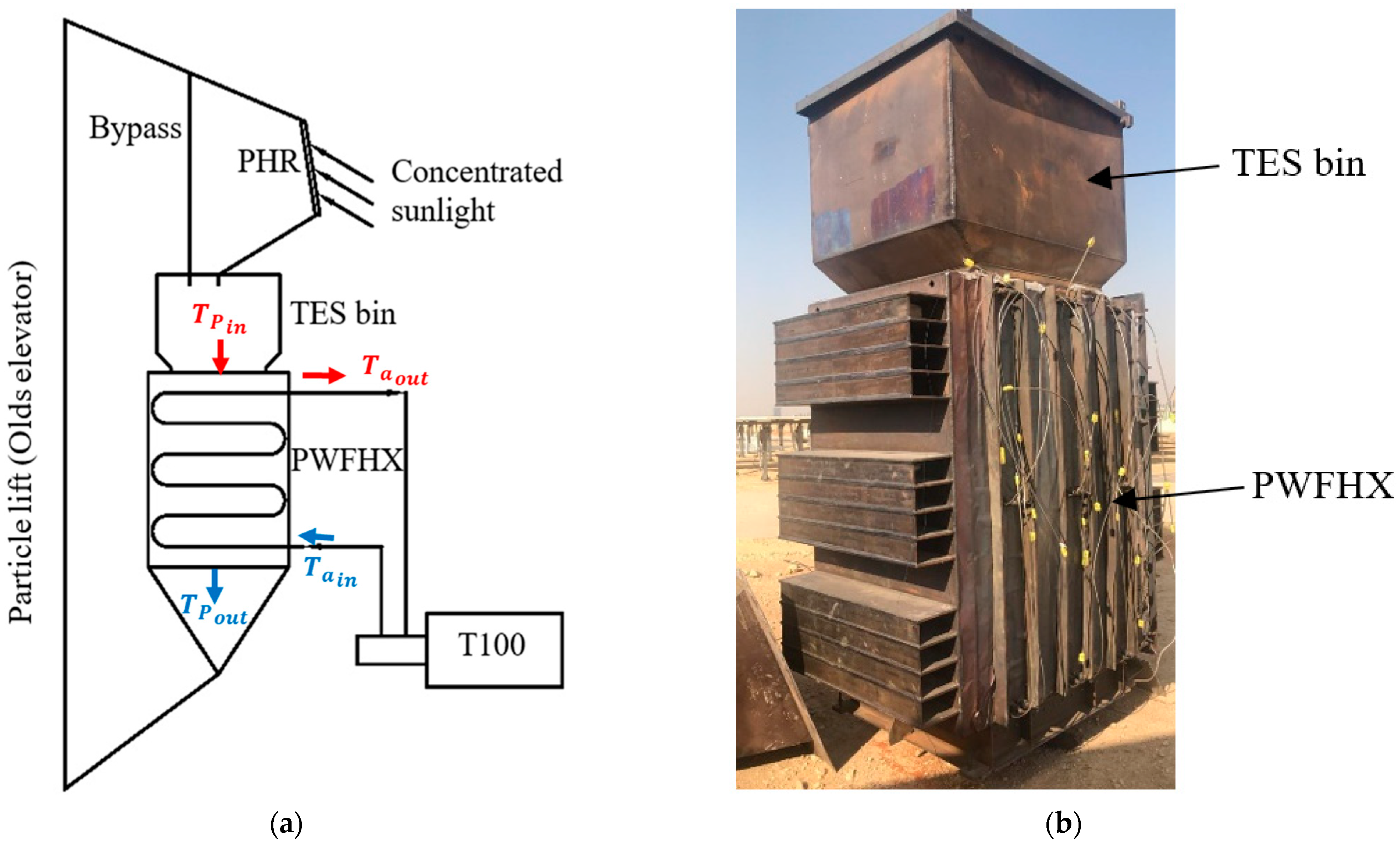

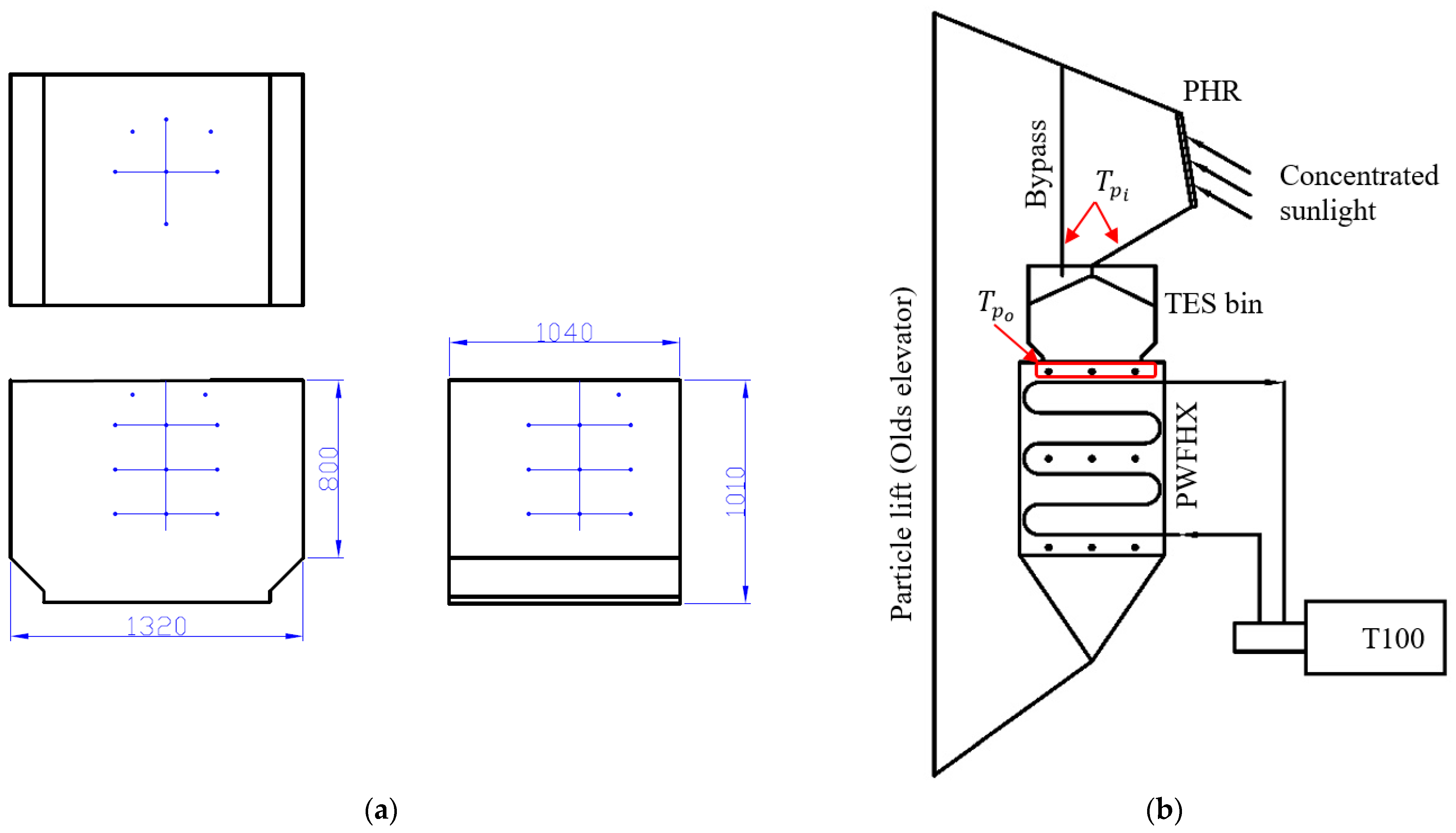
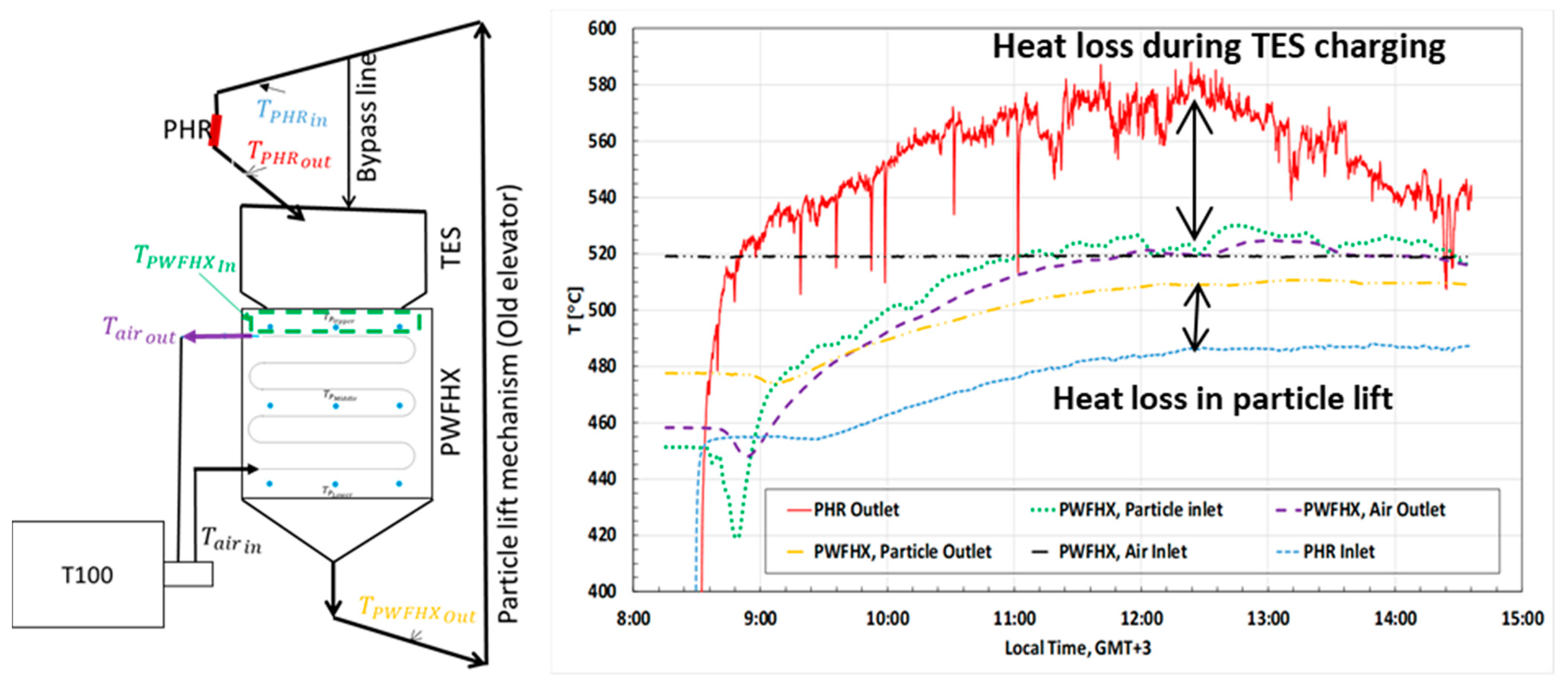
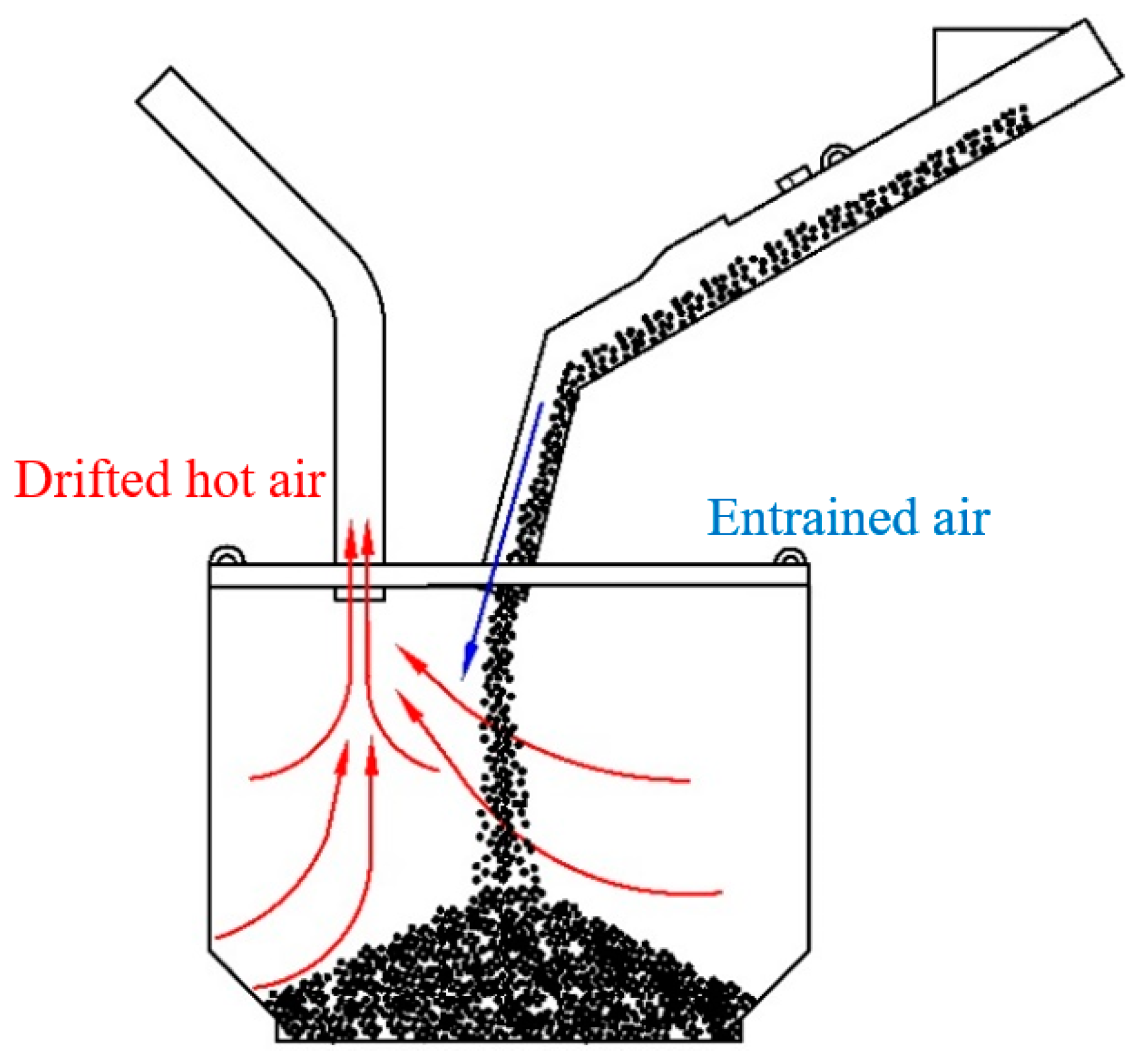
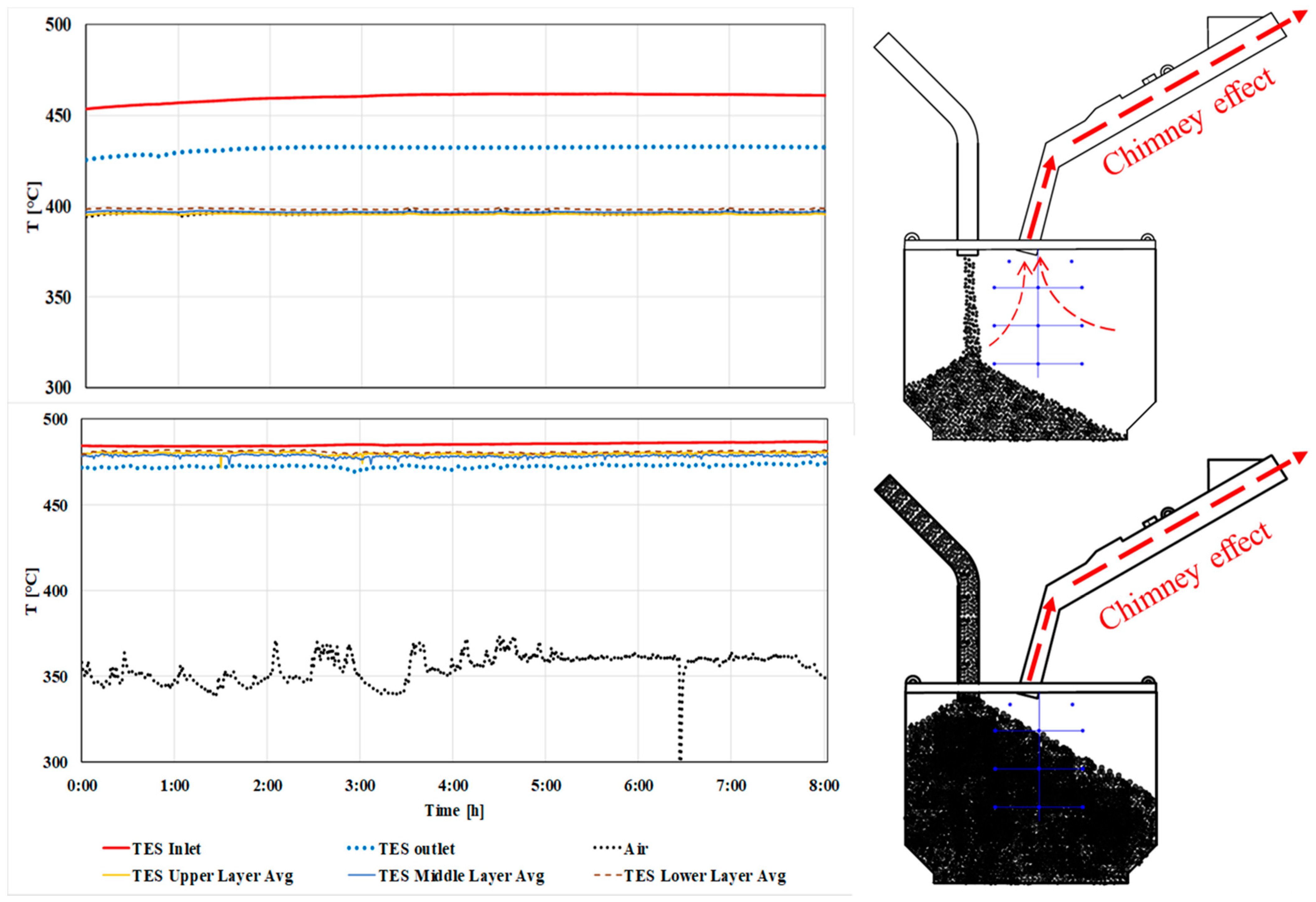

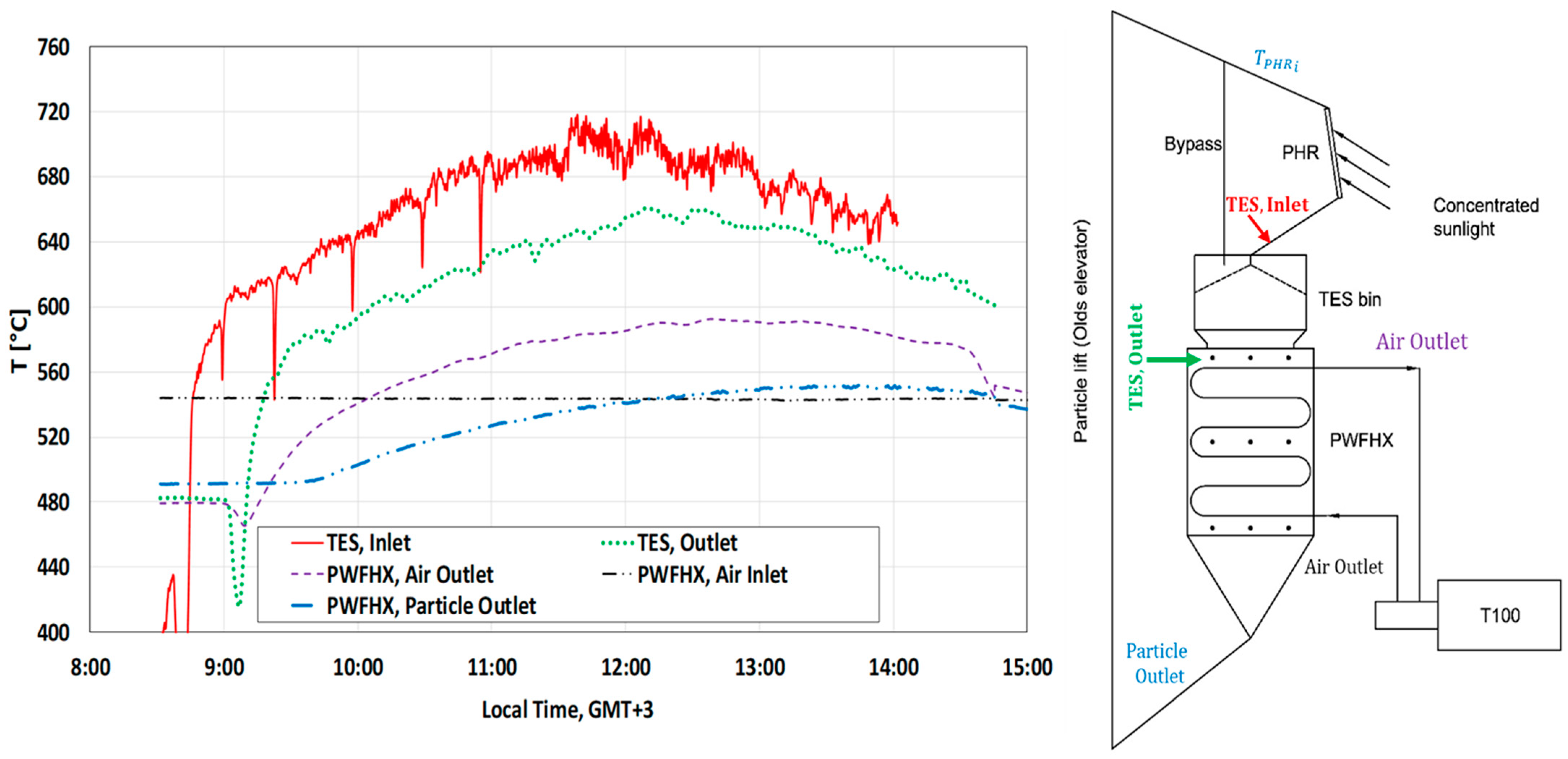
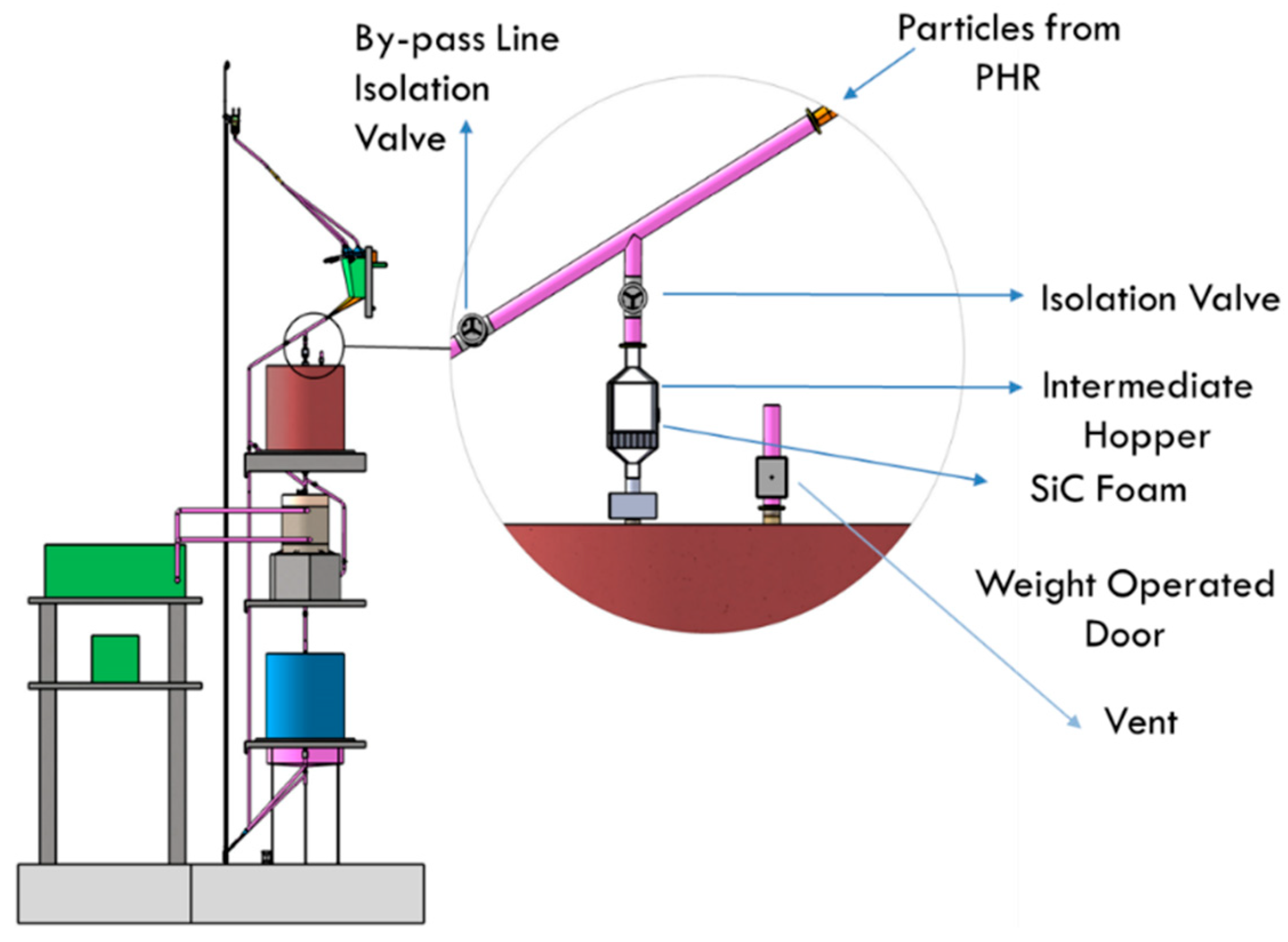
| Particulate | CARBOBEAD CP |
|---|---|
| Chemical composition | 75% (Al2O3), 11% (SiO2) 9% (Fe2O3), 3% (TiO2), and 2% others |
| Heat capacity (kJ/kg-°C) | [16] 50 °C ≤ T ≤ 1100 °C |
| (mm) | 0.3 |
| Agglomeration tendency | Low, small traces of soft agglomeration appeared at 1200 °C [17] |
| Absorptance | 85.25% [17] |
| Angle of repose | 29° [18] |
| Case | ||||||||
|---|---|---|---|---|---|---|---|---|
| 1 | 0.52 | 493.46 | 466.88 | −14.95 ± 0.26 | 0.52 | 543.37 | 461.40 | 46.61 ± 0.23 |
| 2 | 0.93 | 486.46 | 470.88 | −15.66 ± 0.39 | 0.52 | 543.37 | 462.50 | 45.99 ± 0.23 |
| 3 | 1.19 | 485.35 | 472.53 | −16.49 ± 0.50 | 0.52 | 543.39 | 463.42 | 45.49 ± 0.23 |
| 4 | 1.43 | 486.52 | 476.50 | −15.51 ± 0.59 | 0.52 | 543.26 | 467.40 | 43.17 ± 0.23 |
| 5 | 1.57 | 486.80 | 477.33 | −16.09 ± 0.65 | 0.52 | 543.31 | 466.08 | 43.94 ± 0.23 |
Publisher’s Note: MDPI stays neutral with regard to jurisdictional claims in published maps and institutional affiliations. |
© 2022 by the authors. Licensee MDPI, Basel, Switzerland. This article is an open access article distributed under the terms and conditions of the Creative Commons Attribution (CC BY) license (https://creativecommons.org/licenses/by/4.0/).
Share and Cite
Alaqel, S.; Saleh, N.S.; Saeed, R.S.; Djajadiwinata, E.; Alswaiyd, A.; Sarfraz, M.; Al-Ansary, H.; El-Leathy, A.; Al-Suhaibani, Z.; Danish, S.; et al. An Experimental Demonstration of the Effective Application of Thermal Energy Storage in a Particle-Based CSP System. Sustainability 2022, 14, 5316. https://doi.org/10.3390/su14095316
Alaqel S, Saleh NS, Saeed RS, Djajadiwinata E, Alswaiyd A, Sarfraz M, Al-Ansary H, El-Leathy A, Al-Suhaibani Z, Danish S, et al. An Experimental Demonstration of the Effective Application of Thermal Energy Storage in a Particle-Based CSP System. Sustainability. 2022; 14(9):5316. https://doi.org/10.3390/su14095316
Chicago/Turabian StyleAlaqel, Shaker, Nader S. Saleh, Rageh S. Saeed, Eldwin Djajadiwinata, Abdulelah Alswaiyd, Muhammad Sarfraz, Hany Al-Ansary, Abdelrahman El-Leathy, Zeyad Al-Suhaibani, Syed Danish, and et al. 2022. "An Experimental Demonstration of the Effective Application of Thermal Energy Storage in a Particle-Based CSP System" Sustainability 14, no. 9: 5316. https://doi.org/10.3390/su14095316






